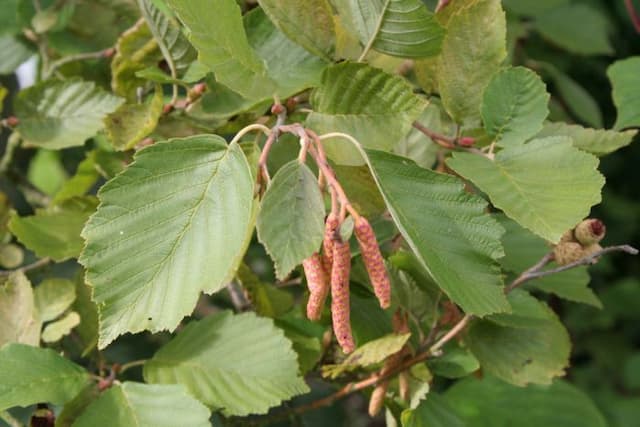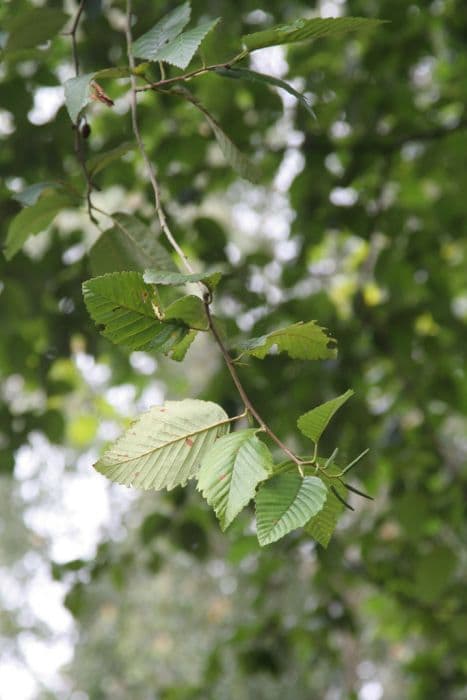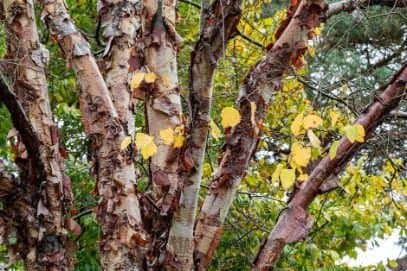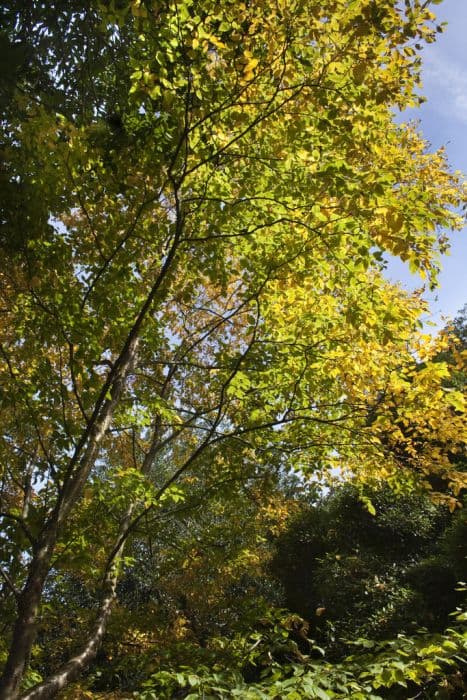Himalayan Birch Betula utilis subsp. jacquemontii 'Doorenbos'

ABOUT
The plant commonly known as the 'Doorenbos' Birch is renowned for its striking white bark that peels off in sheets, creating a contrast against its dark green leaves. This bark becomes whiter and even more pronounced as the tree matures, making it a standout feature in any landscape. The leaves are roughly triangular and have a toothed edge, creating a delicate texture. They change color with the seasons, turning from their lush summer green to golden yellow hues in the fall, adding seasonal interest to the plant. This variety is also adorned with catkins, which are long, cylindrical flower clusters that dangle from the branches in the early months of the year. The catkins add another layer of interest, starting out as green and developing to a brown shade as they mature. Overall, the 'Doorenbos' Birch presents a stunning look with its bright white bark and foliage that provides year-round beauty.
About this plant
 Names
NamesFamily
Betulaceae.
Synonyms
White-Barked Himalayan Birch, Jacquemont Birch, Doorenbos Birch.
Common names
Betula jacquemontii 'Doorenbos', Betula utilis var. jacquemontii 'Doorenbos'.
 Toxicity
ToxicityTo humans
The Himalayan birch is generally considered non-toxic to humans. There are no well-documented cases of poisoning from ingesting parts of the Himalayan birch. However, as with any plant, individual allergies can occur, so it is advisable to avoid ingesting plant material unless it is known to be safe and you have confirmed you do not have an allergy to it.
To pets
The Himalayan birch is also generally considered non-toxic to pets. There is no significant evidence to suggest that ingestion of this plant causes poisoning in domestic animals such as cats and dogs. Nonetheless, pet owners should always monitor their pets and prevent them from eating large amounts of any plant material, as it could potentially cause gastrointestinal upset or an allergic reaction in sensitive individuals.
 Characteristics
CharacteristicsLife cycle
Perennials
Foliage type
Deciduous
Color of leaves
Green
Flower color
Varies
Height
30 feet (9.14 meters)
Spread
20 feet (6.1 meters)
Plant type
Tree
Hardiness zones
7
Native area
Himalayas
Benefits
 General Benefits
General Benefits- Aesthetic Appeal: Betula utilis subsp. jacquemontii 'Doorenbos', commonly known as Himalayan birch, is admired for its striking white bark that provides a stunning visual contrast in gardens and landscapes.
- Wildlife Attraction: The tree offers a habitat and food source for various wildlife, including birds that feed on its seeds and insects that dwell in its bark.
- Shade and Cooling: Its canopy can create a significant area of shade, offering a cooling effect and comfortable outdoor space during the warmer months.
- Erosion Control: The root system of the Himalayan birch helps stabilize the soil and control erosion, especially in sloped areas.
- Adaptability: This birch variety is noted for its ability to adapt to a range of soil types, though it prefers moist, well-drained conditions.
- Seasonal Interest: Beyond its ever-appealing bark, it provides seasonal interest with catkins in the spring and yellow foliage in the autumn.
- Low Maintenance: The 'Doorenbos' variety is a low-maintenance tree once established, requiring minimal care aside from occasional watering and pruning.
 Medical Properties
Medical Properties- Antimicrobial: Betula utilis is known for its antimicrobial properties, which may be attributed to its essential oils and other compounds.
- Anti-inflammatory: Birch bark, including that of Betula utilis, contains compounds such as betulin that may have anti-inflammatory effects.
- Wound Healing: Traditional use of Betula utilis bark involves its application to promote wound healing due to its astringent properties.
 Air-purifying Qualities
Air-purifying QualitiesThis plant is not specifically known for air purifying qualities.
 Other Uses
Other Uses- Betula utilis subsp. jacquemontii 'Doorenbos', also known as White-barked Himalayan Birch, can be used in woodworking to create decorative veneers, thanks to its attractive grain and color.
- The peeling bark of the White-barked Himalayan Birch can be used in craft projects, such as for making natural art or as part of rustic decor pieces.
- The wood of the White-barked Himalayan Birch can be used for producing high-quality paper, particularly artisanal papers or as a substrate for art prints.
- Being naturally lightweight and strong, the wood from this birch species is suitable for crafting musical instruments such as drums or woodwind instruments.
- The wood can also be used to create sports equipment like hockey sticks, cricket bats, or toboggans due to its resilience and flexibility.
- The White-barked Himalayan Birch can be implemented in landscape design to aid in soil stabilization on slopes or banks, countering erosion with its root system.
- Its sap can be tapped and used as a base for syrups and beverages, though not as commonly as the sap from other birch species.
- The birch's wood, when dried, serves as excellent, long-lasting firewood with a high calorific value, suitable for wood-burning stoves and fireplaces.
- The branches and twigs can be used for creating woven goods like baskets or even rustic furniture, depending on the thickness and flexibility of the materials harvested.
- Dried leaves and small twigs of the White-barked Himalayan Birch can be used as natural kindling or for starting campfires due to their easy ignition and abundant oil content.
Interesting Facts
 Feng Shui
Feng ShuiThe Himalayan Birch is not used in Feng Shui practice.
 Zodiac Sign Compitability
Zodiac Sign CompitabilityThe Himalayan Birch is not used in astrology practice.
 Plant Symbolism
Plant Symbolism- Purity: Betula utilis subsp. jacquemontii 'Doorenbos', commonly known as the Himalayan birch, often symbolizes purity due to its striking white bark which stands out in its natural environment, conveying a sense of cleanliness and innocence.
- New Beginnings: The Himalayan birch is associated with new beginnings as it is one of the first trees to grow back after a forest has been cleared or burned, thus representing rebirth and renewal.
- Adaptability: Known to grow in a range of challenging environments, the Himalayan birch is symbolic of adaptability and resilience in the face of difficult circumstances.
- Protection: In various cultures, birch trees are considered protective because they were often planted around homes to ward off evil and are regarded as guardians.
 Water
WaterThe Himalayan birch or Doorenbos birch should be watered deeply, ensuring the soil is thoroughly moistened to the root zone, approximately once a week during dry spells. In the growing season, increase the frequency to twice per week, especially in hot, dry weather. The amount of water should be around 10-15 gallons per watering session for established trees to maintain moist but not waterlogged soil conditions. Cut back on watering during the fall to prepare the tree for winter dormancy, and always check the soil moisture before watering to avoid overwatering.
 Light
LightThe Doorenbos birch thrives best in full sun to partial shade. It is ideal to plant it in a spot where it receives at least 6 hours of direct sunlight per day, though it can tolerate some light shade, especially in the hotter parts of the day. Avoid deep shade, as this can lead to poor growth and a sparser canopy.
 Temperature
TemperatureThe Doorenbos birch prefers temperate climates and can survive in a temperature range from -40°F to around 85°F. The ideal temperature range for optimal growth is between 50°F and 70°F. This birch is cold hardy and can withstand freezing temperatures, making it suitable for many northern climates.
 Pruning
PruningPrune the Doorenbos birch during dormancy in late winter or very early spring before any new growth starts. Pruning is necessary to remove any dead, damaged, or diseased branches, to maintain its attractive shape, and to prevent potential hazards from falling branches. It’s also beneficial to thin the canopy slightly to allow light and air to penetrate, improving the tree’s overall health. Perform structural pruning every 3-5 years or as needed to maintain its form and structure.
 Cleaning
CleaningAs needed
 Soil
SoilHimalayan Birch 'Doorenbos' prefers well-draining soil rich in organic matter with a slightly acidic to neutral pH of 6.0-7.0. A good soil mix can be created by combining loam, sand, and peat to ensure proper drainage and fertility.
 Repotting
RepottingHimalayan Birch 'Doorenbos' trees do not typically require repotting as they are outdoor trees. Instead, they should be planted in the ground where they can grow to their full size.
 Humidity & Misting
Humidity & MistingHimalayan Birch 'Doorenbos' is tolerant of a wide range of humidity levels but prefers average to high humidity environments that mimic its natural habitat.
 Suitable locations
Suitable locationsIndoor
Not suitable for indoor growth due to size.
Outdoor
Full sun, well-draining soil, water regularly during dry spells.
Hardiness zone
5-7 USDA
 Life cycle
Life cycleThe Himalayan birch, specifically the Betula utilis subsp. jacquemontii 'Doorenbos', begins its life cycle as a seed, which requires stratification through a cold period to break dormancy. Upon germination in late spring, the seedling emerges and grows rapidly in its initial years, developing into a young sapling. The sapling stage can last for several years as it establishes a strong root system and grows taller. As an adult tree, the Himalayan birch can reach up to 20-30 feet tall and is characterized by its striking white bark and oval-shaped leaves. This stage of maturity may last many decades, during which the tree produces an abundance of wind-pollinated catkins annually in the spring, leading to seed set and dispersal. In its senescence, the tree's growth slows before eventually dying, but it can live for 50 years or more under optimal conditions.
 Propogation
PropogationPropogation time
Spring-Early Summer
Propogation: The most popular method of propagation for the Himalayan Birch, specifically Betula utilis subsp. jacquemontii 'Doorenbos', is through the cultivation of seeds. Optimal seed sowing should be carried out in the autumn, as this aligns with their natural cycle of germination following a cold period. Seeds are to be sowed in well-drained, sandy or a loamy medium, thinly covering them with soil. They require exposure to light and varying temperature cycles to incentivize germination. A consistent, gentle watering schedule is essential to keep the soil moist but not waterlogged, fostering the right conditions for seedlings to emerge. Once the seedlings have reached a sufficient size and can be handled, they are typically pricked out into individual containers and allowed to grow on in a protected environment before eventual planting out into their final location.









